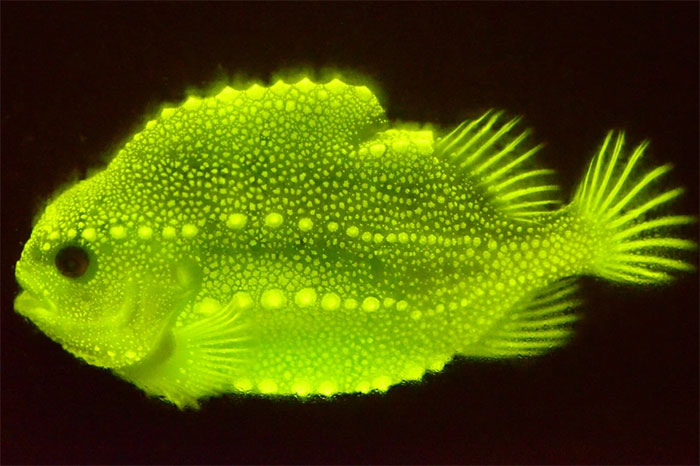Scientists discovered the special properties of lumpfish, a fish that lives on the bottom near shore in many areas in the northern Atlantic and Arctic oceans.
If you ask the question: “What color is lumpfish?” , you will get many different answers.
This fish changes color over time, and at each age they will have a certain color. However, recently scientists believe they have found their true color – fluorescent green .

Lumpfish look quite funny and are often raised on salmon farms because they eat sea lice, which help clean the salmon’s habitat. (Photo: Reddit/u/NinjaKamihana).
Famous for TikTok
In a study published this month in the scientific journal Journal of Fish Biology, the authors said they discovered that lumpfish glow when placed under UV light.
They believe that these fish use their biofluorescent radiation to recognize and communicate with each other.

In recent years, researchers have discovered many animals with biofluorescence capabilities, including cat sharks, koalas, flying squirrels or platypuses. And lumpfish is the newest name on this list.
Lumpy fish, Cyclopterus lumpus , are solitary and spend most of their lives on the seabed. They have the ability to attach their abdomens to surfaces such as rocks or seaweed. This body structure evolved from the pelvic fin and acts like a suction cup.

With a rather funny facial expression, the lumpfish is also very famous on the social network TikTok, with thousands of videos about this fish recorded by researchers or fishermen.
“This is a pretty odd fish,” said Nathaniel Spada, a research assistant at the Woods Hole Oceanographic Institution, Massachusetts. Although he did not participate in the study, Mr. Spada’s videos about lumpfish have been viewed millions of times on TikTok.
“I didn’t think they (videos of lumpfish) would become so popular, but I should have imagined that because they are actually very interesting fish,” Mr. Spada added.

Last year, Mr. Thomas Juhasz-Dora, a veterinarian working as a doctoral student at the University of Cork in Ireland, suddenly became curious when looking at the bulging eyes of a lumpfish in the laboratory. . He suddenly came up with an idea.
Having witnessed the glow under UV light in some marine species, Mr. Juhasz-Dora wanted to know whether lumpfish possess this property or not. He collected 11 juvenile fish and photographed them under different lighting conditions.
Under normal light, lumpfish are blue mixed with green like a sponge. But when exposed to UV rays, their entire bodies emit neon blue light.

Lumpfish radiate a strong neon blue color when standing under a UV light. (Photo: Thomas Juhasz-Dora).
“I felt like ‘Wow’,” Dr. Juhasz-Dora shared. He was surprised by the strong fluorescence intensity of lumpfish. This phenomenon occurs when certain organisms absorb ultraviolet (UV) rays, which are invisible to the naked eye, and re-emit them as a visible color, typically red. , orange or green.
This is different from bioluminescence, where an organism produces its own light through a chemical reaction within its body.
Colorful fish

Many animals have special filters in their corneas that allow them to see biofluorescence without the help of UV light.
Dr. Juhasz-Dora hypothesizes lumpfish are also equipped with such filters, allowing them to somehow signal to exchange information with others, while remaining hidden from predators.
According to Ms. Elizabeth Fairchild, a researcher and associate professor at the University of New Hampshire with expertise in lumpfish and many other types of seafood, Mr. Juhasz-Dora’s hypothesis is completely feasible.
Lumpfish can also use their biofluorescence to attract prey. But Dr. Fairchild thinks it’s more likely that they use this tool to communicate.
“Communication is probably the most likely answer. We just don’t know what they are communicating,” Ms. Fairchild said.
It is also possible that biofluorescence serves no specific purpose. However, Dr Fairchild, who was not involved in the study, said this was unlikely, given the importance of color to lumpfish.
“Lumpfish have an impressive ability to change color. When young, they can take on every color of the rainbow. When they grow a little, they can change their skin color based on their surroundings, helping hide from predators,” Ms. Fairchild explained.
“When they reach adulthood, lumpfish change their skin color from light gray to light blue. However, during the breeding season they change color again, males will turn orange-red and females will turn blue.” , the doctor added.

An adult lumpfish. (Photo: University of Maine).
How and why bioluminescence appears in lumpfish is one of many questions raised by Dr. Juhasz-Dora’s findings. He and his colleagues are currently studying whether these fish have the ability to control their fluorescence, or if it is completely passive.
According to Dr. Juhasz-Dora, his and his colleagues’ findings “opened the door to new discoveries.”
“It allows us to see the world from their perspective (the lumpfish), instead of our own,” he said.





